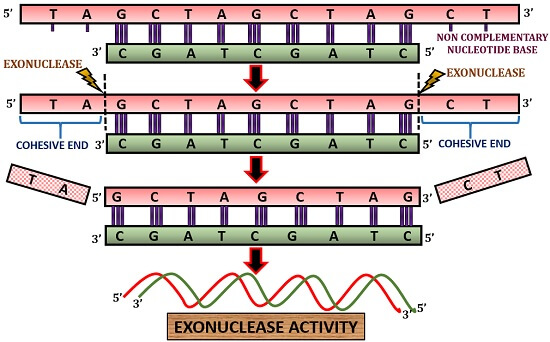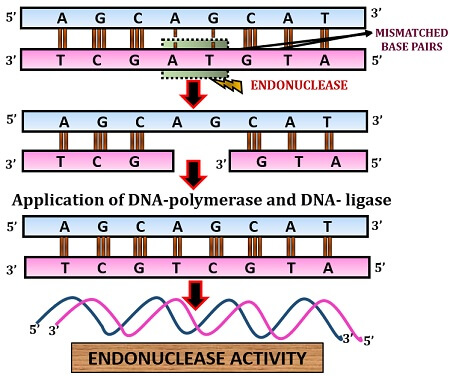The difference between endonuclease and exonuclease is mainly due to the two properties like mode of action and the site of cleavage.
- Mode of action: Endo-nuclease cuts the nucleotide bases from the middle by breaking the phosphodiester backbone of nucleotide. Exo-nuclease cuts the nucleotide bases at the ends by breaking the phosphodiester backbone of nucleotide either from the 5’ or 3’ end.
- Site of Cleavage: Endo-nuclease cuts the nucleotides that are interior to the polynucleotide chain. Exo-nuclease cuts the nucleotides that are present at the exterior ends of the polynucleotide chain.
The nuclease is an enzyme that breaks the polynucleotide chain by hydrolysing the phosphodiester bond that holds the nucleotides together. It is mainly of two types, namely endonuclease and exonuclease. In this context, we will study the key differences between the endonuclease and exonuclease, along with the comparison chart. Also, we will discuss the meaning, properties and mechanisms of both the processes.
Content: Endonuclease Vs Exonuclease
- Comparison Chart
- Definition
- Differences in Properties
- Similarities in Properties
- Mechanism
- Key Differences
- Conclusion
Comparison Chart
| Properties | Endonuclease | Exonuclease |
|---|---|---|
| Mode of action | It separates the nucleotides into two or more fragment | It removes the nucleotides one by one from the fragment |
| Site of occurrence | Cleavage occurs in the middle of the polynucleotide chain | Cleavage occurs at the end of the polynucleotide chain |
| 3’ or 5’-OH groups | Do not require | It requires |
| Lag-phase | Undergo lag period before their activity | Absent |
| Specificity | Sequence-specific | Non-specific |
| Result | It releases oligonucleotides | It releases nucleosides |
| Role | Plays an important role in DNA repair and also blocks the entry of the pathogens | Plays an important role in DNA repair, stabilization and proofreading but does not blocks the entry of the pathogens |
Definition of Endonuclease
The term endonuclease can be understood by breaking the term into endo and nuclease, in which a former means interior and a latter stand for the catalyst for the hydrolysis of the nucleic acid. Therefore, the endonuclease enzyme creates a nick between the polynucleotide chain to form oligonucleotides. It does not require free 3′ or 5′ ends to create a nick. These can be either sequence-specific or non-specific. Sequence-specific endonuclease includes restriction enzymes that create nick at the specific site only, whereas the non-specific endonucleases can cut the DNA or RNA from anywhere in the strand.
Definition of Exonuclease
The term endonuclease can be understood by breaking the term into exo and nuclease, in which a former means exterior and a latter stand for the catalyst for the hydrolysis of the nucleic acid. Thus, the exonuclease enzyme creates a nick at the ends of the polynucleotide chain, for which it requires free 3′ or 5′ ends. It results in the formation of individual nucleosides. These are sequence non-specific.
Differences in Properties
- Endo-nuclease cuts the nucleotide chain in between, whereas exonuclease cuts it from the ends.
- Exonuclease cleaves the phosphodiester bonds of the polynucleotide chains either at 3’ or 5’ end, while endonuclease cleaves the phosphodiester bonds that are present within the polynucleotide chain.
- Endo-nuclease directly cuts the polynucleotide chain and results into two or more fragments, whereas exonuclease cuts the nucleotide bases one by one from 3’ or 5’ end.
- Endo-nuclease creates a single-stranded nick within the chain, whereas exonuclease removes the single nucleotides from the end.
Similarities in Properties
Both endonuclease and exonuclease share some similar properties where they show similarities in their function.
- Endonuclease and exonuclease can act upon the nucleic acids, i.e. both DNA and RNA.
- Both endonuclease and exonuclease are the nuclease enzymes, which performs the cleavage of the nucleotide chain of DNA or RNA.
- Endo-nuclease and exonuclease both can hydrolyse the phosphodiester linkage of DNA and RNA.
Mechanism of Exonuclease
Exonuclease first attacks on the phosphodiester bond and removes the nucleotides one by one from the polynucleotide chain. The ends that are overhanging from the strand are called cohesive or sticky ends. After the removal of cohesive ends, both the DNA overlaps to make a complete DNA hybrid or a segment.

Mechanism of Endonuclease
Endo-nuclease first breaks the phosphodiester bond of the mismatched nucleotide bases. Then, it separates the whole mismatched base pairs. After that, endonuclease forms the DNA hybrid with the help of DNA polymerase and DNA ligase, in which a former polymerized the strand and a latter binds the fragment. At last, the endonuclease creates a nick.

Key Differences Between Endonuclease and Exonuclease
- The mode of action of the endonuclease is to separate the nucleotide chain into two or more fragments, whereas exonuclease separates the nucleotides at a time from a polynucleotide chain.
- The site of cleavage for endonuclease is in between the polynucleotide chain, while for exonuclease it is at the ends of the chain (either at 3′ or 5′).
- Endo-nuclease does not require 3′ or 5′-hydroxyl groups for the cleavage, whereas exonuclease requires the 3′ or 5′-hydroxyl groups for the cleavage.
- The specificity of endonuclease is sequence-specific, whereas exonuclease is non-specific.
- Endo-nuclease undergoes lag phase before their activity, while exonuclease does not undergo lag phase.
- Exonuclease results in the formation of nucleoside that are the monomer units of nucleotide without a phosphate group. Endonuclease results in the formation of oligonucleotides that are the short sequences of nucleotides.
Conclusion
We have discussed the difference in properties, mechanism and the key differences between the endo and exonuclease. Hence, we can conclude that both endonuclease and exonuclease are the enzymes having different activity site for the cleavage. Besides, their main function is to separate the mismatched or wrong nucleotides base, and they play an important role in DNA repair and stabilization.